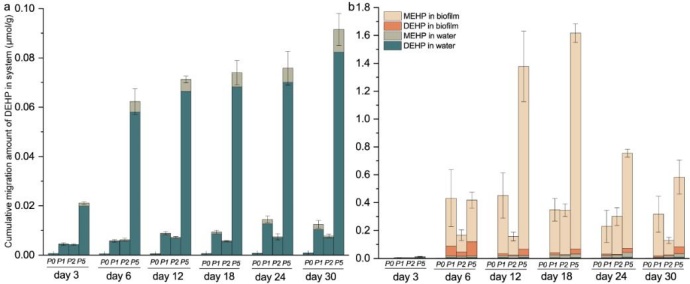Highlights
Effect of Biofilm Forming on the Migration of Di(2-ethylhexyl) phthalate from PVC Plastics
As plastic products become an indispensable part of our daily lives, their environmental impact becomes a growing global concern. A significant concern associated with plastic pollution is the release of plastic additives, especially plasticizers. Phthalates make up about 70% of the plasticizer market. These chemicals are known as endocrine disruptors and pose significant risks to both aquatic ecosystems and human health. Understanding the environmental behavior of phthalates is essential for evaluating their ecological risk.
Since phthalates are not covalently bonded to the polymeric matrix and exist in a leachable form, they migrate into the environment easily upon disposal of phthalate-containing products through plastic aging and decomposition. In natural settings, the environmental behavior of additives in plastics may be influenced by biological activities, in addition to being regulated by various physical and chemical parameters. Biofilms inevitably form on plastic surfaces when plastic enters the aqueous environment. However, current research on the impact of biofilm growth on plastic surfaces in relation to phthalate release remains limited, despite its potential significance.
Recently, a research group led by Prof. WU Chenxi from the Institute of Hydrobiology (IHB) of the Chinese Academy of Sciences provided new insights into the environmental behavior of phthalates in plastics from the perspective of biofilm on plastic surfaces. This study was published inEnvironmental Science & Technology.
In a microcosm experiment, this study found that biofilm growth on plastic surfaces could increase the release of phthalates, employing PVC plastics with varying levels of the DEHP, the most common phthalates. First, by measuring the concentrations of DEHP in the aqueous solutions of the biofilm growth and biologically inhibited control groups, the researchers found that, except for the plastics without DEHP, the concentrations of DEHP in the aqueous phases of the biofilm growth groups for all types of plastics were significantly lower than those of the control groups during the whole experiment.
In the biofilm growth groups, biofilm attachment was evident on the plastic surface. Consequently, the researchers quantified the contents of DEHP in the biofilm and its main metabolite monoethylhexyl phthalate (MEHP) in the experimental system. The researchers found that the concentrations of MEHP in the aqueous solution of the biofilm growth groups were significantly higher than those of the control groups for all of plastics. And the contents of MEHP in the biofilm was significantly higher than the contents of DEHP, which indicated that the biofilm on the surface plastic adsorbed and degraded the DEHP released from the plastic.
“We further assessed the cumulative migration amounts of DEHP in the experimental system to explore the impact of biofilm on DEHP migration in PVC plastics,” said researchers. It revealed that the cumulative amount of DEHP in the system of the biofilm growth groups, across various DEHP contents in PVC plastics, was significantly higher compared to the control group.
This study demonstrates that surface biofilms can significantly enhance the leaching of additives from plastics. Concurrently, these surface biofilms, acting as a novel interface between plastics and the surrounding environment, exert influence on the transport and transformation of the additives released plastic through barrier, adsorption, and degradation in the environment. The significance of this emerging interface is especially crucial in natural environments, given that plastics entered aquatic environments will inevitably be attached to biofilms. Future research should endeavor to investigate the transport dynamics and fate of plastic additives under different biofilm compositions, alongside evaluating the ecological risks stemming from the bioaccumulation of plastic additives within biofilms.

Fig. 1 Schematic representation of the effect of biofilm on DEHP release from plastics

Fig. 2 Cumulative migration of DEHP and MEHP per gram of plastic in the system for control and biofilm growth groups
(Editor. WANG Hongxia)